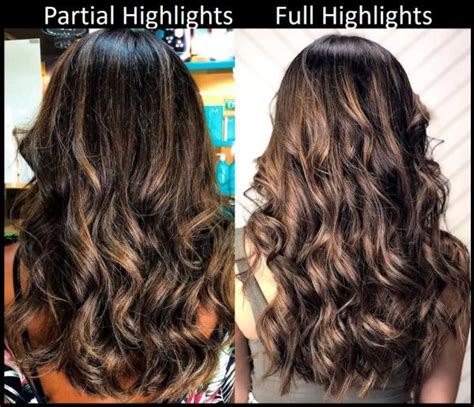Introduction:

Hair highlights have become an integral part of modern hair styling, adding depth, dimension, and a touch of glamour to any look. But when faced with the decision between partial and full highlights, the choice can be overwhelming. Both techniques offer unique advantages and disadvantages, making it crucial to understand the differences before taking the plunge.
Partial Highlights: A Subtle Enhancement
Partial highlights, also known as babylights or lowlights, involve strategically placing thin streaks of color throughout the hair. This technique creates a subtle, natural-looking effect that enhances the hair’s natural texture and depth.
Advantages:
- Low maintenance: Partial highlights require less frequent touch-ups compared to full highlights.
- Less damaging: Since only a portion of the hair is colored, the damage to the hair is minimized.
- Versatile: Partial highlights can be customized to create a wide range of looks, from sun-kissed to dimensional.
Disadvantages:
- Limited color range: Partial highlights typically use shades close to the base color, limiting the range of colors available.
- Less dramatic: Partial highlights create a more subtle effect compared to full highlights.
- Can be time-consuming: The application process for partial highlights can be longer than for full highlights.
Full Highlights: A Bold Transformation
Full highlights, also known as a full head of foils, involve applying color to all or most of the hair. This technique creates a bolder, more dramatic effect that can transform the entire look.
Advantages:
- Maximum impact: Full highlights create a striking, eye-catching look that can drastically alter the hair’s appearance.
- Versatile: Full highlights can be customized to create any desired color or pattern.
- Long-lasting: With proper care, full highlights can last for several months before requiring a touch-up.
Disadvantages:
- High maintenance: Full highlights require frequent touch-ups to maintain the vibrancy of the color.
- More damaging: Bleaching the entire head of hair can cause significant damage, leading to dryness and breakage.
- Expensive: Full highlights are typically more expensive than partial highlights due to the amount of time and product required.
Key Differences
| Feature | Partial Highlights | Full Highlights |
|---|---|---|
| Amount of hair colored | 20-50% | 70-100% |
| Color intensity | Subtle | Bold |
| Maintenance | Low | High |
| Damage | Low | High |
| Cost | Lower | Higher |
Choosing the Right Technique
The best choice between partial and full highlights depends on individual preferences and hair goals. Here are some factors to consider:
- Hair type: Thinner hair may be better suited for partial highlights to avoid overwhelming the strands.
- Current hair color: Darker hair requires more bleaching for full highlights, increasing the potential for damage.
- Desired effect: Partial highlights are ideal for a natural, sun-kissed look, while full highlights create a bolder, more transformative effect.
- Budget and maintenance: Full highlights require more frequent touch-ups and higher maintenance costs.
Common Mistakes to Avoid
- Over-highlighting: Avoid using too much bleach or overlapping highlights, as this can lead to breakage and uneven color.
- Ignoring color theory: Choose shades that complement your skin tone and natural hair color.
- Rushing the process: Highlighting takes time and patience. Allow enough time for the hair to process and avoid over-developing the color.
- Using low-quality products: Invest in high-quality bleach and hair care products to minimize damage and ensure a healthy finish.
- Not consulting a professional: Seek the advice of a licensed hairstylist to determine the best highlighting technique and care routine for your specific hair needs.
Step-by-Step Highlighting Process
Partial Highlights:
- Section the hair and apply bleach to thin strands throughout the head using a brush or foil.
- Process the bleach according to the manufacturer’s instructions.
- Rinse and condition the hair.
- Style as desired.
Full Highlights:
- Section the hair into thin, even slices.
- Apply foil to each section.
- Paint bleach onto the hair on the foil.
- Process the bleach according to the manufacturer’s instructions.
- Rinse and condition the hair.
- Style as desired.
Conclusion
Partial vs. full highlights is a personal decision that depends on individual hair goals and preferences. By understanding the differences between these techniques, you can make an informed choice that will transform your hair and elevate your style.
